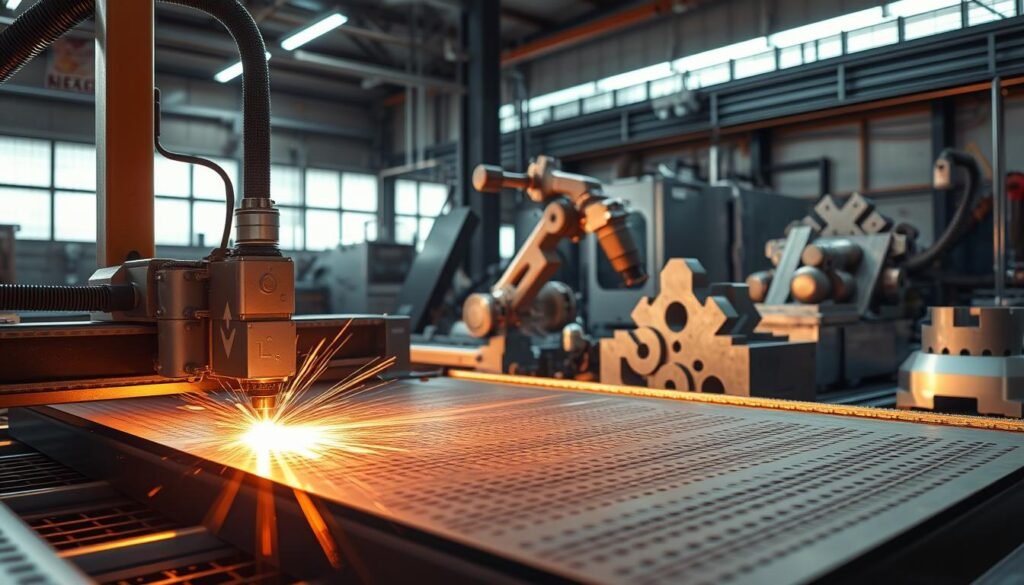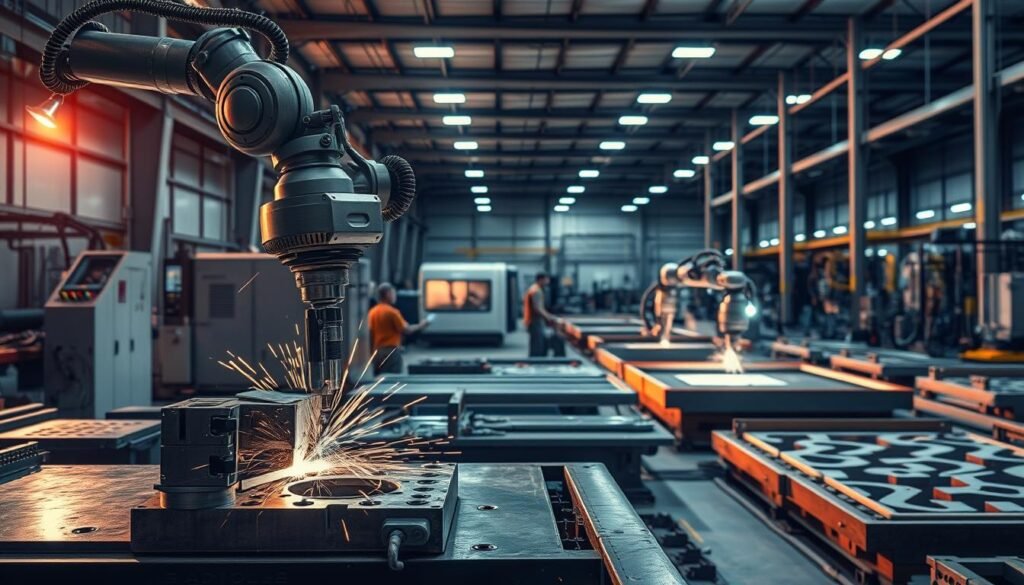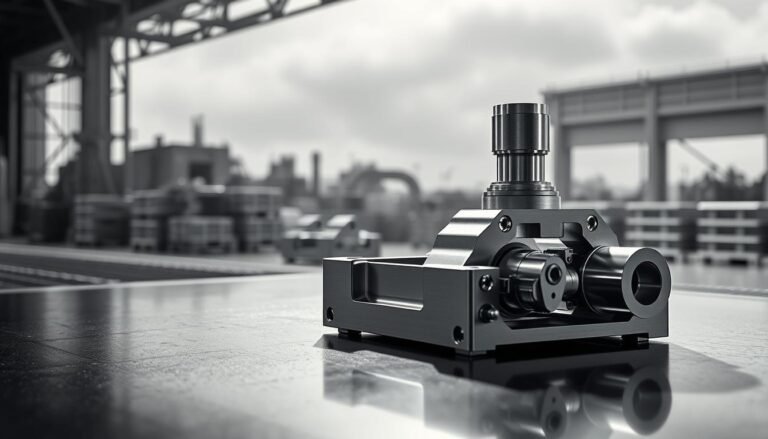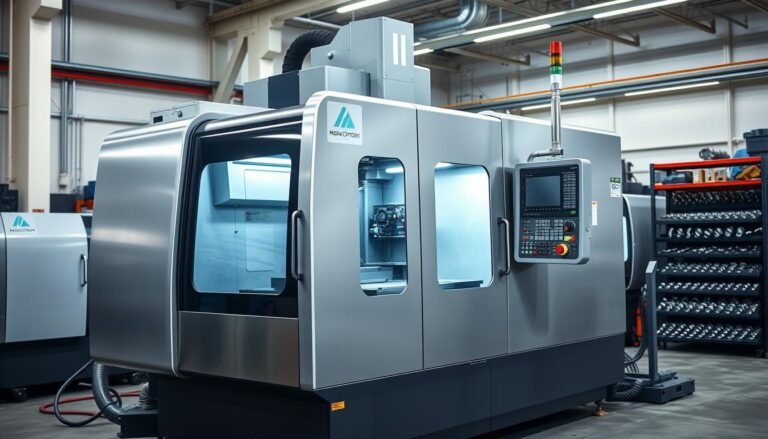Many industries rely on a detailed process that is vital for pushing forward innovation. Sheet metal fabrication molds flat metal into useful shapes. Through this, we see how sheets turn into important parts that change technology and how things work.
This isn’t just a process; it’s like a perfect orchestra. Every cut and fold must be exact to create high-quality parts. These parts are everywhere in our lives, from phones to planes. The process doesn’t stop at making parts. It includes improving their look and performance with extra treatments.
Our group of experts works hard to transform metal into parts that are precise and useful. Our goal is to turn great ideas into real items perfectly. This is crucial for new inventions to become a success.
Key Takeaways
- Sheet metal fabrication is essential for producing metal components with high precision.
- Advanced manufacturing techniques are employed to ensure products meet exacting industry standards.
- The fabrication process entails cutting, forming, and assembling to achieve desired structures.
- Innovation and precision in fabrication cater to a broad spectrum of industry applications.
- Post-processing and finishing are integral for functionality and aesthetic enhancement of metal components.
An Introduction to Sheet Metal Fabrication
Sheet metal fabrication is key in modern making of things. It’s used to make parts and assemblies for many industries. With precise techniques, metal sheets turn into important shapes and products for new technology.
This method helps make strong products. It also adapts to different needs in cars, planes, and buildings.
Definition and Scope
Sheet metal fabrication works with thin, flat metal pieces. They are shaped into various forms. This work depends on tools and machines, and choosing the right metal is critical.
Importance in Modern Manufacturing
Adding sheet metal work into making things offers strong, exact parts. It’s crucial for high-end industrial uses. This pushes what we can make and do today.
Materials Used in Sheet Metal Fabrication
The metal used depends on what the product needs and where it will be used. Here’s a list of common metals, showing what they’re good for and where they’re typically used:
| Metal | Properties | Applications |
|---|---|---|
| Steel | High strength, durable, cost-effective | Building frameworks, automotive bodies |
| Aluminum | Lightweight, corrosion-resistant | Aircraft parts, food packaging |
| Copper | Excellent electrical conductivity | Electrical components, roofing materials |
| Stainless Steel | Rust-resistant, hygienic | Medical devices, kitchen appliances |
This info shows how choosing the right metal matters a lot. It helps make exactly what’s needed.
The Sheet Metal Fabrication Process
Our company uses various modern cutting technologies and fabrication techniques. We work with flat metal sheets to create precise parts for many industries. Our work includes expert-guided precision cutting, advanced shaping, and strong metal joining. We always meet the top industry standards.
We start with cutting, using laser, waterjet, and plasma methods. These are great for precision cutting and keep waste low. They’re ideal for detailed designs and hard metals, showing our focus on quality and efficiency.

Forming processes like bending and stamping come next. Our skills in bending processes and stamping operations let us mold metals into complex shapes. This keeps the metal strong and durable. Our techniques make sure each piece is precision-made.
Our last step involves joining techniques such as welding and riveting. We pick each method to match the project needs, making our solutions flexible and strong.
For more on our fabrication methods and their advantages, look at this detailed guide on sheet metal fabrication.
Design Considerations for Sheet Metal Fabrication
We help our clients understand important design steps in sheet metal fabrication. Using CAD modeling and choosing the right materials are key. They greatly enhance the final product’s efficiency and quality.
CAD software is vital for making detailed designs. It works well with manufacturing software. This matches the designs with real-world production, following design for manufacturing principles. These principles make production easier and more doable.
Choosing the right material matters a lot. Factors like thickness, grain direction, and how it reacts under stress are critical. They affect the product requirements. They also influence what tools and techniques we can use in making the product.
We focus on strong production guidelines and design accuracy. This approach improves process efficiency. It also ensures each design phase is perfect for scaling up and sustainability in production.
To make a product manufacturable, we look at where features go, the needed tolerances, and how material choice affects making it. This thorough look helps us avoid future production problems and reduces risk.
Adding these design steps early on makes the making process better. It cuts down waste and boosts production efficiency. This smart planning makes us leaders, creating manufacturing solutions that fit our clients’ engineering and design needs perfectly.
Advanced Technologies in the Sheet Metal Fabrication Process
In the world of sheet metal fabrication, CNC machining and 3D printing are game-changers. They represent the amazing growth of automated manufacturing and additive manufacturing. These methods have made making complex parts faster, more precise, and more innovative.
CNC Machining and Its Role
CNC precision has changed sheet metal work. It automates cutting, drilling, and milling, speeding up production and reducing mistakes. This shift to machines ensures parts are made consistently well. It’s vital in fields where every detail matters.
The Revolution Brought by 3D Printing
The use of 3D printing applications has reshaped sheet metal work. It allows for building parts layer by layer. This method makes it easy to create complex shapes. Shapes too hard to make before. It also speeds up the making of prototypes. This fast tracking lets designers try out ideas quickly.

CNC machining and 3D printing improve how sheet metal is made. They make manufacturing more dynamic, efficient, and cheaper. These technologies are now key in modern making methods.
Common Applications and Industries
Sheet metal fabrication is key in many industries because of its flexibility and toughness. It’s crucial in aerospace engineering and the car industry. These fields need accuracy and dependability. Sheet metal is also used to make electronic enclosures and strong construction materials. This shows how varied sheet metal solutions can be.
In aerospace and auto fields, the strength and lightness of metal are critical. They help make vehicles safe and efficient. For more details on sheet metal’s role, check out this informative article.
When it comes to building and electronics, sheet metal is vital. It’s used in parts that look good, work well, and last long. From electronic enclosures that keep parts safe to construction materials that stand up to the weather, sheet metal is key to innovation and design.
| Industry | Application of Sheet Metal | Benefits |
|---|---|---|
| Aerospace | Airframe components, Engine mounts, Paneling | High strength-to-weight ratio, Corrosion resistance |
| Automotive | Body panels, Frames, Engine parts | Durability, Ease of manufacturing, Customization |
| Electronics | Enclosures, Component mounts, Racks | Electromagnetic shielding, Heat dissipation, Protection |
| Construction | Roofing, Siding, HVAC components | Longevity, Recyclability, Energy efficiency |
The amazing thing about sheet metal versatility is not just its flexibility. It’s vital for growth and success in modern industry and engineering.
Conclusion
Throughout this article, we’ve explored the fine details of sheet metal fabrication. This technique is crucial to today’s manufacturing. It is used in many industries, like cars and planes, showing how precise work creates top-quality parts. The blend of new tech and better industrial practices has taken this process to new heights.
Our company leads in blending modern tech with traditional fabrication methods. We focus on precision. By using CNC machining and 3D printing, we aim to go beyond what manufacturing pros expect from us.
The exploration of cutting, shaping, and joining metal shows this method’s flexibility and wide range. With expertise, we aim to boost how industries work. Our goal is to stay ahead in making things with precision, helping your businesses grow with our knowledge and new ideas.
FAQ
What is sheet metal fabrication?
Sheet metal fabrication turns flat metal sheets into certain shapes or parts. This process uses cutting, forming, and assembling. It needs precision to ensure the end products are of high quality and accurate.
Why is sheet metal fabrication important in modern manufacturing?
Sheet metal fabrication is key to making lots of products we use every day. It plays a big role in sectors like aerospace, automotive, and electronics. It helps these industries innovate and advance.
What materials are typically used in sheet metal fabrication?
Many metals are used, including steel, aluminum, copper, and special alloys. The choice depends on what the final product will be used for. Factors like durability, weight, and strength are considered.
How are cutting techniques like laser, waterjet, and plasma cutting used in fabrication?
These cutting methods are used to cut metal sheets accurately into desired shapes. Laser, waterjet, and plasma cutting are different but all offer precision and speed. They can cut through various metal thicknesses without damaging the metal with heat.
What is involved in the forming process of sheet metal fabrication?
The forming process makes three-dimensional shapes from cut metal sheets. Methods like bending, stamping, and rolling are used. The choice depends on the shape and specifications needed for the finished product.
What are the typical joining methods used in sheet metal fabrication?
For creating the final piece, methods like welding, riveting, and bonding are used. The best method depends on the project and what it needs.
Why is Computer-Aided Design (CAD) important in sheet metal design?
CAD is very important because it helps make accurate digital models. These models are crucial for a successful manufacturing process. CAD makes sure designs are practical and match the material’s properties. This leads to accurate dimensions and easier CNC machine use.
How is the appropriate metal material selected for a project?
Choosing the right metal involves looking at thickness, type, and use of the final product. This ensures the product works well and lasts long, meeting the project’s and industry’s needs.
What factors affect manufacturability in sheet metal fabrication?
Several things impact how easy it is to make something, including how parts are laid out. Bending needs and the order of making things matter a lot. Designing with manufacturing in mind is key to avoiding mistakes.
How has CNC technology influenced sheet metal fabrication?
CNC technology has changed sheet metal fabrication by making parts with great detail and accuracy. It makes sure each piece meets the client’s needs, whether it’s a single prototype or mass production.
What role does 3D printing play in sheet metal fabrication?
3D printing adds to sheet metal fabrication by making parts with complex shapes easier to create. It’s good for making prototypes quickly and for custom projects.
In which industries is sheet metal fabrication commonly used?
It’s used a lot in industries like aerospace and automotive where strong, light parts are needed. Electronics use it for making things like enclosures. It’s also used in construction for parts that are strong and look good, such as roofing and siding.




